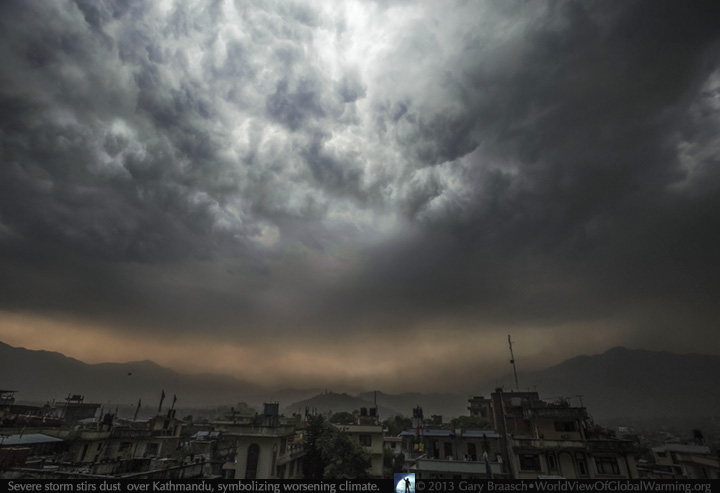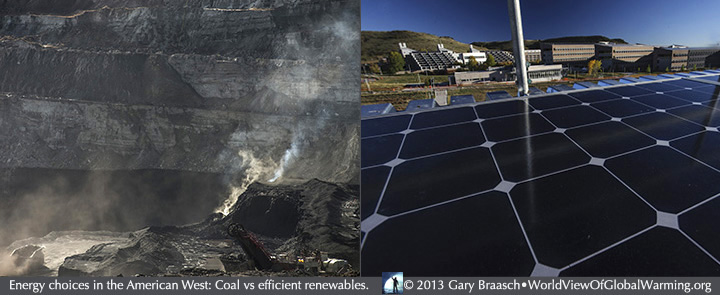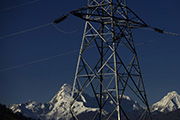Climate Photo of the Week
Scientists' perspective of on-rushing climate change: "No 'hiatus.'" "Unfamiliar territory." "Politics trumps substance."
Nepal and all the Himalayas are undergoing climate changes including more severe storms, early and very heavy monsoon downpours, drought and loss of snowmelt in middle elevations of the mountains.
Scientists from around the world gathered in San Francisco at the end of 2014 to deliver reports of new studies and research to their fellows at the annual American Geophysical Union (AGU) meetings. The entire Solar System's physical and geological make-up is on the agenda of this week-long assembly, with reports from NASA space and Mars probes and from deep ocean and high mountain research programs. What humans are doing to our home planet probably was the most crucial subject.
The AGU science reports that we attended painted a grim picture of how the Earth's natural systems are being stressed under human-caused climate change -- and how quickly we must reduce greenhouse emissions. Leaders in climate science repeatedly described "the new normal" in rising sea level rates, high Arctic temperatures and ice loss, worldwide mountain glacier thaw, and increasing ocean temperature and acidification. Each field of climate science has its uncertainties, they said, but they are about rates of change and process, not about the trends and causes. More and more CO2 and other greenhouse gases are being pumped into the atmosphere and scientists at AGU warned that the gases and their effects would continue for centuries -- and thus that every additional molecule of CO2 from any nation matters. Said one leading atmospheric scientist of this connection, "it's almost inconveniently simple." The research underlies and underscores the international reviews of science being issued through 2014 by the Intergovernmental Panel on Climate Change (IPCC).
In sessions about how scientists can discuss their work and its implications with the public and policy makers a Congressional staff member said they should frame their scientific results in human and personal perspectives, but warned that in Washington now, "politics trumps substance."
Here, a sampling of other quotes we heard at the AGU:
"There is no 'hiatus,' really, in global warming." -- Kevin Trenberth, Distinguished Senior Scientist, National Center for Atmospheric Research
"Climate-wise, we are in unfamiliar territory." -- Lonnie Thompson, Glaciologist, expert in loss of alpine glacier worldwide.
"Never forget this: CO2 remains in the atmosphere long after emissions."
"After 1000 years we still have 40 percent of the CO2" active in the atmosphere. -- Philippe Ciais, Laboratorie des Sciences du Climat et de l'Environnement, France, and the Global Carbon Project
Sea level rise will continue "for many centuries after 2100." -- Jonathan Gregory, UK Met Office
"We cannot undo these changes," except over hundreds of years. -- Kirsten Zickfeld, Geography, Simon Fraser University
“What’s the use of having developed a science well enough to make predictions if, in the end, all we’re willing to do is stand around and wait for them to come true?” -- Sherwood Roland, Nobel Laureate for chemistry of the ozone hole, as quoted by Gavin Schmidt, NASA Goddard.

In a special issue, Destruction, art, and the Doomsday Clock, the Bulletin of the Atomic scientists explores how we are influenced for good or ill by the images we see of nuclear proliferation and rapid climate change. Gary Braasch was commissioned to investigate the history and usefulness of the tens of thousands of photographs, charts, graphs, cartoons, illustrations, and moving images that we have seen about global warming. The content of climate imagery falls into several broad categories, Gary writes, and not all of them have been effective in educating people about the dangers and causes of climate change or encouraging civic action and involvement. Documented research and experience shows that a new framing of local climate impacts and positive actions may encourage more people to take action.

The U.S. government energy policy of "All of the Above" plays out grandly across the Western landscape. It spans from the upper great plains of Montana and North Dakota, where crude oil production was over 900,000 barrels a day in August, and in Wyoming where coal mining provided most of the US supply -- across to Oregon and Washington's Columbia River where hydropower has been created since the 1930s but wind is a major energy source now. World View of Global Warming's detailed photo story about the Powder River Basin coal region is the first in a new series on The Daily Climate about western energy today. Thanks to Scientific American and Grist for re-posting this story for their readers.
And look for more on energy and how to be an active, concerned citizen on our Action Pages.
Other recent stories available on World View of Global Warming
A lone scientist reveals the meaning of a melting Arctic Ocean: “You don’t have to care about Arctic seabirds or pack ice,” George Divoky told World View of Global Warming, because the Arctic is not the only place where climate change is causing problems. “Species are struggling to deal with it,” he says, “and we are going to be in the same situation.” Please see story and portfolio here.
In the Pacific Northwest, the oyster industry, with an $84 million yearly value and 3,000 employees, is already seeing and reacting to the effects of unhealthy ocean water.
Story and photos here.
The fabled Himalayan kingdom of Bhutan stands alone among nations for its strong Buddhist faith, Constitutional concern for the happiness of its people, a monarchy that gave up power to establish democracy, its preservation of ecosystem,s and as the only nation to sequester much more carbon than it emits. In recent years, Bhutan, like other Himalayan areas, has seen an increase in landslides due to heavier rains, and some glacial lake outburst floods (GLOFs) as glaciers retreat. Our report from a visit to this unique nation, which faces difficult choices among ecosystems and energy needs, may be seen here.
COPYRIGHT NOTICE:
Photography and text Copyright © 2005 - 2017 (and before) Gary Braasch All rights reserved. Use of photographs in any manner without permission is prohibited by US copyright law. Photography is available for license to publications and other uses. Please contact requestinformation@worldviewofglobalwarming.org. View more of Gary Braasch's photography here.



